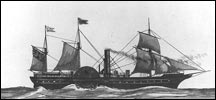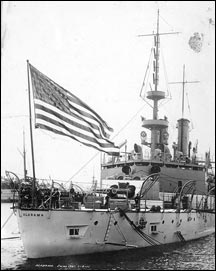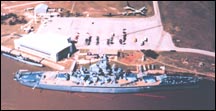| Alabama at Sea
By William Sariego
May 2017
Nostalgia can be a powerful thing, sometimes
taking on a life of its own and building a
legacy in your memory greater than the reality
you are remembering. An early memory for me,
with a lasting and undeniable affect, is of
Battleship Parkway, straddling Mobile Bay
between Baldwin and Mobile counties, where
I spent the majority of the first 15 years
of my life. Visiting the U.S.S. Alabama was something I often and enthusiastically
did as both a young boy and a young man. My
interest never waned, though certain aspects
of my visits, such as the pinup of Betty Grable
in one of the crews’ quarters, became
more fascinating after a time.
Second
World War at Sea: Arctic Convoy, which features that wonderful relic of my
youth, is a perfect excuse to practice my
historical writing.
The Forerunners
BB60 is actually the fifth ship in our nation’s
history to bear the name of my native state.
The first Alabama was a small, sidewheel
steamer (displacing 127 tons) and was built
for riverine service for the War Department
at Brownsville, Pennsylvania. Launched in
March of 1849, her service career was short,
only seven months, before she was discovered
to be unfit for service. She was sold to a
private citizen in New Orleans in October
of that same year.

The second Alabama.
|
The second Alabama was a larger sidewheel
streamer (1,261 tons) that was built as a
merchant ship at New York in 1851. She was
purchased by the United States Navy in 1861
and refitted with eight 32-pounders and attached
to the South Atlantic Blockading Squadron
for the first two years of the War Between
the States, and did yeoman’s service
capturing four blockade runners. After the
crew was stricken with Yellow Fever off the
coast of Florida in the summer of ’63
she was temporarily pulled out of service.
She spent the last year of the war in the
Atlantic Blockading Squadron and participated
in the bombardment of Fort Fisher —
the largest amphibious operation in U.S. history
until WWII. She would be decommissioned in
July 1865.
During the same conflict, the Confederate
States of America had her own Alabama, commanded by Raphael Semmes (whose statue
overlooking Mobile harbor was another minor
Mecca for me as a kid). Built in England,
she displaced 1,050 tons and carried six 32-pounders,
one 68-pounder, and a 110-pound gun. The CSS Alabama’s 21-month career would
see the commerce raider take 60 prizes worth
over $6,000,000 and defeat the U.S.S. Hatteras in combat. Her career came to an end off Cherbourg,
France on June 19th 1864, being sunk in a
memorable duel with the more powerful U.S.S. Kearsarge.
The next U.S.S. Alabama was a genuine
battleship, BB8 to be exact. Built in Philadelphia
and launched in May 1898, she had the following
dimensions: 374 feet overall with a beam of
72 feet and a displacement of 11,565 tons.
Manpower was 40 officers and 496 men. Her
armament consisted of four 13-inch guns, fourteen
6-inch guns, sixteen 6-pounders, six 1-pounders,
four .30 machine guns and four 18-inch torpedo
tubes. Her armor plate had a maximum thickness
of 16.5 inches, which actually compared well
with her later counterparts (though of course
not made to the same metallurgical standards),
and she could make 16 knots.

The old battleship Alabama.
|
Initially, she operated off the Eastern seaboard
and in the Caribbean. In 1904 she went on
overseas duty to Europe, and was visited by
the King and Queen of Greece. In 1907 she
would join the “Great White Fleet”
in its world tour. BB8 was placed in reserve
in 1908. She would be in and out of service
over the next decade for purposes of training
and would serve as a gunnery training ship
during WWI while stationed at Norfolk.
BB8 was finally decommissioned for good in
1920, and would be sunk for target practice
off Tangier Island in experimental bombing
practice on September 27th, 1921.
Our Hero
The Congressional Act of 17 May 1938 would
authorize the building of what would become
known as the South Dakota class (South
Dakota, Indiana, Massachusetts, Alabama). Built at Norfolk, BB60’s keel was laid
on 1 February 1940. She would be launched
on 16 February 1942 and commissioned on 16
August 1942. When authorized, the United States
was still bound by the Washington Naval Treaty
and the class had an authorized displacement
of 35,000 tons.
Her main armament was nine 16-inch guns
and 20 five-inch guns. Her anti-aircraft armament
would be continually strengthened during the
war, beginning with 24 40mm quad mounts and
12 single 20mm guns; before being increased
to 48 and 56 respectively, in February 1945.
Belt armor was 12.2 inches but tapered and
inclined, was the equivalent of 17 inches
of vertical plating. The faces of her main
turrets were 18 inches thick, and the conning
tower was 16 inches thick, to mention two
other key areas. She could reach 27.8 knots
and displaced 44,500 tons fully loaded in
1942. er compliment of men was 127 officers
and 2,205 enlisted personnel. Six hundred
eighty feet overall with a beam of 108 feet,
she dwarfed her stout little predecessor.

Launching Alabama.
|
Her operational history would begin in the
Atlantic. After being commissioned and undergoing
a shakedown cruise, BB60 would spend the next
year, until August of 1943, in the ETO. She
was initially assigned to Task Force 22, which
was built around the aircraft carrier Ranger.
After only a few months, however, she joined
her sister ship, South Dakota, and
five destroyers and headed to Scapa Flow.
There the American ships would serve the under
Admiral Sir Bruce Frazier and the British
Home Fleet. Her main duty in European waters
was part of the famous “Murmansk Run,”
in which lend lease supplies were sent to
the Soviet Union to aid in the defeat of Nazi
Germany.
Alabama would be sent to the Pacific,
arriving in the New Hebrides on September
14th, 1943. She would go on to win nine Battle
Stars for Pacific campaigns, the Navy Occupation
Medal (Asia) from her own government, and
the Philippine Republic’s Presidential
Unit Citation Badge. The nine Battle Stars
were for the following campaigns.
The Gilbert Island Operation, called Operation
Galvanic, saw BB60 form part of the protection
screen for Yorktown. In this manner she took
part in the bombardment of Tarawa. The Marshal
Islands Operation saw the occupation of Kwajalein
and Majuro Atolls in Operation Flintlock.
Then came the Asiatic-Pacific Raids which
covered a great deal of territory (including
Operational Scenario One), with Alabama again
performing duty as carrier protection, due
to her fast speed. She would claim four definite
kills of Japanese planes, and be the temporary
flagship of Admiral Marc Mitscher in March.
During the time frame of the Battle Star earned
for the raids, BB60 would be a vital part
of Task Force 58, centered around the carrier
Enterprise during the Hollandia Operation,
covered by Operational Scenario Two.

Gunnery practice.
|
The Marianas Operation, involving over 500
ships, would be greatly remembered by the
crew of BB60, as she again escorted Enterprise in this key operation. While bombarding the
west coast of Saipan, the air reconnaissance
revealed many Japanese ships coming from the
Philippines. Many ships were redeployed to
meet the threat, including BB60. On June 19th
the first phase of the massive air battle
would begin.
Alabama was one of few ships in the
entire American fleet that had been equipped
with the new SK radar. Alabama picked
up the first wave of Japanese aircraft at
the amazing range of 190 miles! Captain Kirtland
doubted the radar officer until at 150 miles
he was convinced and reported the contact.
The admiral was also dubious, until contact
was confirmed by Iowa at 130 miles. Before
the day was done the Task Force commander
would radio for the entire fleet to hear;
“To Iowa, well done; to Alabama, very well done!” The Imperial Japanese
Navy would lose 400 planes and three carriers
over 19th-20th June. After the “Turkey
Shoot,” Admiral Hanson, commander of
Battleship Division Nine, would make BB60
his flagship for the invasion of Guam, where
Army and Marine troops hit the beach on July
21st.
The came the Western Carolines Operation,
with Alabama playing handmaiden to
the carrier Essex in what was known
as Operation Stalemate II. This included raids
on the Volcano-Bonin and Yap Islands and the
occupation of the Palau Islands. Operational
Scenario Five covers this successful action.
Her star for the Leyte Operation would include
being a part of the largest naval battle in
history, and the centerpiece of the new monster
game of the same name. From Okinawa to Formosa, Alabama screened carriers across the
western Pacific in preliminary operations
(see Operational Scenario Seven) before being
pulled back to assist at Luzon. Alabama’s
anti-aircraft gunners would score three confirmed
kills (some accounts have four) on October
18th. Troops began to go ashore on the 20th
and then the IJN would send the vast majority
of her remaining surface fleet in a desperate
attempt to halt the American tide.
In the opening stages of the battle Alabama operated alongside carrier Enterprise, an old friend, near Surigao Strait, as
the carrier’s aircraft helped deal with
the IJN’s southern force. The she sailed
northward to engage the IJN central force
off Cape Engano. Operational Scenario Eight
covers the action. If the Marianas Turkey
Shoot destroyed Japan’s naval aviation,
Leyte Gulf effectively destroyed her surface
fleet.
After Leyte the Alabama would base
out of Ulithi and participate in minor operations
around Luzon. During the time frame of the
Mindoro Operation (scenario eleven) she received
storm damage from winds approaching 83 knots,
losing both her Kingfisher Scout planes. She
would then be withdrawn from the war zone
for over four months, undergoing refit at
Puget Sound Shipyard in Bremerton, Washington.

Anti-aircraft guns and directors.
|
Her eighth Battle Star would come for the
Okinawa-Gunto Operation. Operation Iceberg,
the invasion of Okinawa, would begin on April
1st and Alabama would not enter the
theater until over a month later escorting Enterprise, hence her absence from
scenario 16. For the purist, add the two ships
to the Turn 361 reinforcements. This operation
would see the height of the kamikaze attacks,
with Alabama’s AA fire accounting
for three planes. Again, she escaped serious
damage, excepting from the typhoon of that
hit over the course of June 4th and 5th.
Her ninth battle star would come for operations
against Japan. Under Halsey’s 3rd Fleet, Alabama at first performed her familiar
duty of fast carrier escort. She then was
detached in the face of minimal Japanese resistance,
to bombard the home islands with her massive
16-inch guns. She would perform the bombardment
missions with an old Royal Navy comrade from
the Murmansk days, HMS King George V. The end of Imperial Japan had come. . . .
When the war was over Alabama would
re-enter her grateful country when passing
under Golden Gate Bridge on October 15th,
1945. Over the next few weeks, previewing
her eventual fate, over 9,000 civilians came
aboard to pay respects to the valiant ship
and her sailors. Alabama would be decommissioned
at Puget Sound on 9 January 1947. On 1 June
1962, BB60 was officially stricken from the
navy’s list, and she awaited the scrap
yard, a fate which had already descended on
many of her comrades.
The Mobile Chamber of Commerce had other
ideas. It was estimated that to tow the ship
5,600 miles would cost about $1,000,000. A
state-wide campaign to raise money was the
result. Awards were given out for large donations.
For $100 you were given a commission as a
rear admiral in the Alabama Navy, for $500
a vice admiral, and for an even grand, a full
admiral! In less than two years the money
was raised, even allowing for rising costs!

Alabama at her memorial, submarine Drum astern.
|
I long gave my father grief over this
event. A veteran of the United States Army,
he was at the time a civilian technician working
for the U.S. Air Force (I, the Red Goblin,
would be born amidst the fund raising on 1
October 1963). If William J. Sariego Sr. had
donated more than the $25 he did, he could
have effectively served all three branches
of the military. As it was, the Alabama Navy
had one battleship (she would later add the Gato-class submarine, Drum) and more admirals than any fleet in history!
The Navy (the U.S. Navy, that is) officially
turned over the ship to the state of Alabama
on 16 June 1964. She would arrive under tow
at Mobile Bay on 14 September 1964. The focal
point of a 100-acre military park, Alabama is a monument to the men and women who have
served this country. She has also served as
the set of more than one Hollywood movie!
A trip down Battleship Parkway is well worth
your time. Alabama is a classy lady
who helped defend the freedoms many enjoy
today.
Send Alabama into battle. Order Arctic Convoy right now!
|
